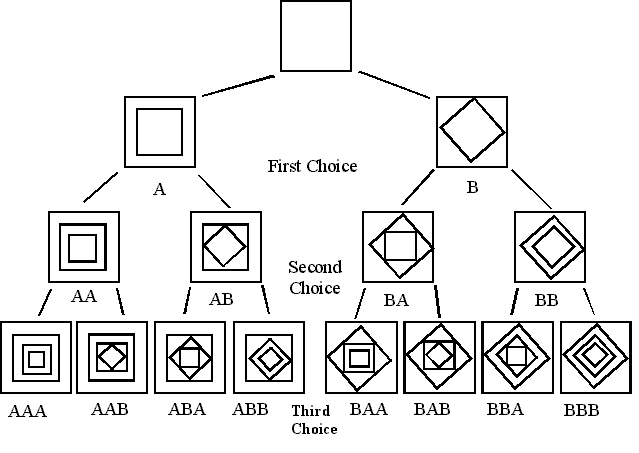The Rainbow Mandala Maker encourages creative experimentation. One of the ways it does so is by approaching art as a "game." The medium and the materials used are those of the collage method of paper construction, a way of arranging and holding together different shapes and colors of papers. The interplaying "teams" in the game are the two most basic geometric shapes the circle and the square representing a long list of opposites, among them: heaven and earth; father and mother; day and night; up and down; happy and sad; warm and cold; summer and winter; the visible and the invisible; mind and heart; what we think and what we feel. To construct a square/circle/square/circle design is to kinesthetically experience the uniting of opposites. Before or while putting a mandala together, if a particular pair of opposites comes to mind, the creative process becomes more meaningful and symbolic. This giving of meaning to geometric figures is something human beings were doing thousands of years ago in their stone chiselings and on cave walls. Color, more recently, has come to be recognized as a symbolic language, one that speaks to and for the emotional self, as when a person "sees red" or "feels blue," is "soothed" by green or "warmed" by yellow. The larger-than-life collages of Henri Matisse are examples of the power of pure and simple color in a carefully balanced spectrum. About his art Matisse observed, "I'm simply using colour to express my feelings." On another occasion this most skillful of all colorists noted, "Colour and line are forces, and in the play of these forces, in their balancing, lies the secret of creation."
In
creating mandalas children may be encouraged to express their feelings and
their conflicts, and in particular to incorporate the ambivalence by
which feelings and conflicts typically are colored. |
|
This
variation of the Infinite Possibilities Mandala Maker® is designed
to use 8 1/2" x 11" colored papers, such as Astrobrights, which are
readily available in school and office supply stores or from printing
shops. Construction papers may also be used but the colors usually are
not as pure as other, non-construction papers. |
||
|
Below is a sample of seven
colors--red, orange, yellow, green, turquoise, indigo, and violet. All but
the indigo and the turquoise are Astrobrights, with all selected
for a balanced range of spectrum values. |
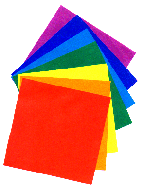 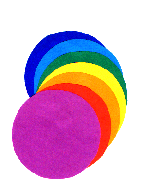 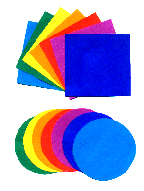 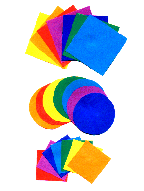 |
|
For one complete Rainbow Mandala Maker assembly you will need:
For making the patterns you will need:
Using graft paper and the compass, draw and cut out three circles sized
Next, using graft paper and a ruler, mark off and cut out four squares sized
For sturdier and more permanent patterns, trace around the paper patterns, transferring their outlines to lightweight cardboard, cardstock or manila paper. (Old file folders work fine for this.)
You now
have a Rainbow Mandala Maker for playing the three Circle/Square Design Games
described below. |
This theme of this game is creative choice-making. It requires seven color choices--one for each of the Mandala Maker's seven levels. Each level offers a choice of seven colors. The square or the circle for each of the levels is proportionately sized to fit inside the previous one. As squares and circles are alternately centered, one on top of the other, the seven-leveled mandala is built. Beginning with the group of largest squares, a color is chosen and placed on one of the white background pieces. This procedure is repeated, with one color chosen from each of the other six size/shape groups. There is no rule limiting choice or suggestion that colors not be repeated. For uniformity, the basic rules of the game are:
Note: For a reusable version of the game, when the arrangement is complete, fasten the design together with a brass paper fastener. In this case, and using a single hole punch or an ice pick, pre-punch holes in the center of each shape. For accuracy, make center holes on the exact center of the patterns and use as a guide. To mark the center of the squares, draw lines diagonally connecting opposite corners. The point of the compass will already have marked the centers of the circles. (Actually the compass point may be used for making center holes.)
AN ALTERNATE METHOD FOR
LARGER GROUPS: |
|
Some children, from even an early age, are fascinated with numbers and math, and find the mathematics of making a seven-leveled mandala of particular interest. On a more subtle level, mandala-making math can address--implicitly or explicitly--the more philosophical matter of choice-making in a universe of infinite possibilities. To begin with, when having seven color choices on seven levels, the total color-combination possibilities is 823,543. But in addition, and because there are three "inner" squares, each of which may be placed squarely or diagonally, eight design arrangements are possible. (See below.) These eight increase the color-combination/design possibilities to 6,588,344. As long as all of the Mandala Maker's 49 color/shape pieces are intact each mandala made is just one of 6,588,344 possibilities. However, as soon as a first mandala is fastened together, then there are only six pieces of each shape, or 42 pieces altogether. Applying the same mathematics as above, the possibilities are now six to the seventh power, or 279,936 color-combination possibilities. These times the eight design possibilities reduce the overall possibilities to 2,239,488. For a third mandala, where the choices are five colors on each of the seven levels, the color-combinations possibilities equal 78,125, which when multiplied by eight (taking into account the design-arrangement possibilities) yields 625,000. The regressive mathematical possibilities when making all seven mandalas are: 7 x 7 x 7 x 7 x 7 x 7 x 7 = 823,543 x 8 = 6,588,344 6 x 6 x 6 x 6 x 6 x 6 x 6 = 279,936 x 8 = 2,239,488 5 x 5 x 5 x 5 x 5 x 5 x 5 = 78,125 x 8 = 625,000 4 x 4 x 4 x 4 x 4 x 4 x 4 = 16,384 x 8 = 131,072 3 x 3 x 3 x 3 x 3 x 3 x 3 = 2,187 x 8 = 17,496 2 x 2 x 2 x 2 x 2 x 2 x 2 = 128 x 8 = 1,024 1 x 1 x 1 x 1 x 1 x 1 x 1 = 1 x 8 = 8
|
